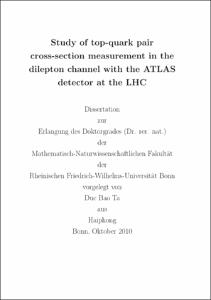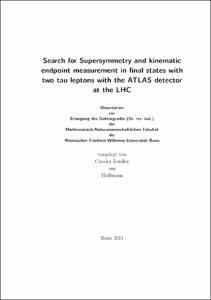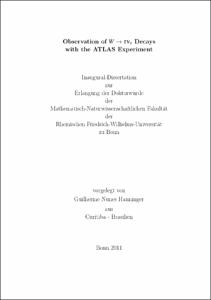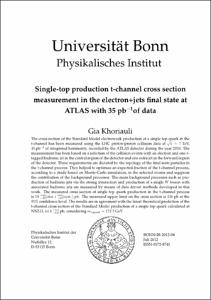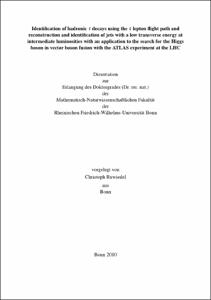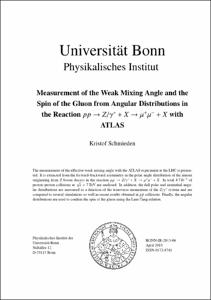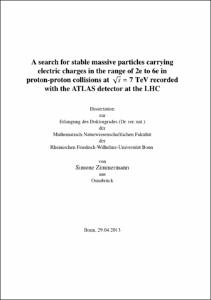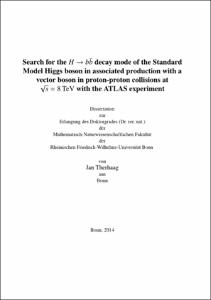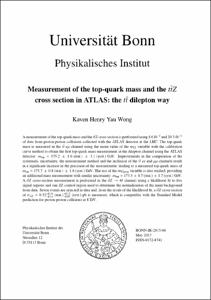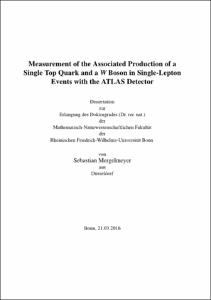E-Dissertationen: Search
Now showing items 1-10 of 13
Study of top-quark pair cross-section measurement in the dilepton channel with the ATLAS detector at the LHC
(2011-09-16)
The top quark is the heaviest of the known fundamental particles in the Standard Model (SM) with a mass of 173.3±1.1GeV. It is the sixth quark in the SM and the weak isospin partner of the bottom quark. Properties such as ......
Search for Supersymmetry and kinematic endpoint measurement in final states with two tau leptons with the ATLAS detector at the LHC
(2011-10-21)
Discovery prospects for Supersymmetry in final states with at least two tau leptons and large missing transverse energy are evaluated for LHC proton-proton collisions measured with the ATLAS detector. In a first study based ......
Das Entdeckungspotential von Supersymmetrie mit Endzust¨anden aus mindesten zwei Tau Leptonen und fehlender Transversalenergie in Proton-Proton Kollisionen wird untersucht, sowie die M¨oglichkeit einer Messung des Endpunktes ......
Das Entdeckungspotential von Supersymmetrie mit Endzust¨anden aus mindesten zwei Tau Leptonen und fehlender Transversalenergie in Proton-Proton Kollisionen wird untersucht, sowie die M¨oglichkeit einer Messung des Endpunktes ......
Observation of W → τντ Decays with the ATLAS Experiment
(2011-05-04)
Physics studies of processes with t leptons in the final state, while challenging at hadron colliders, are of great importance at the LHC. The τ leptons provide important signatures in searches for the Higgs boson as well ......
Single-top production t-channel cross section measurement in the electron+jets final state at ATLAS with 35 pb-1 of data
(2012-09-03)
The cross section of the Standard Model electroweak production of a single top quark in the t-channel has been measured using the LHC proton-proton collision data at $sqrt{s}=7$ TeV, $35 {\rm pb}^{-1}$ of integrated ...
Identification of hadronic τ decays using the τ lepton flight path and reconstruction and identification of jets with a low transverse energy at intermediate luminosities with an application to the search for the Higgs boson in vector boson fusion with the ATLAS experiment at the LHC
(2010-07-01)
Three studies of different components of the object reconstruction with the ATLAS experiment using simulated data are presented. In each study, a method for the improvement of the reconstruction is developed and the ...
Measurement of the Weak Mixing Angle and the Spin of the Gluon from Angular Distributions in the Reaction pp → Z/γ* + X → μ+μ- + X with ATLAS
(2013-11-15)
The measurement of the effective weak mixing angle with the ATLAS experiment at the LHC is presented. It is extracted from the forward--backward asymmetry in the polar angle distribution of the muons originating from $Z$ ...
A search for stable massive particles carrying electric charges in the range of 2e to 6e in proton-proton collisions at √s = 7 TeV recorded with the ATLAS detector at the LHC
(2013-09-02)
This dissertation presents a search for long-lived, multi-charged particles using the ATLAS detector at the LHC. Motivation for this search arose from an unexploited search regime at ATLAS of stable massive particles with ...
Search for the H → b¯b decay mode of the Standard Model Higgs boson in associated production with a vector boson in proton-proton collisions at √s = 8 TeV with the ATLAS experiment
(2014-06-11)
In this thesis, a search for the H→b¯b decay mode of the Standard Model Higgs boson in associated production with a vector boson is presented. The search is based on the entire data-set recorded by the ATLAS experiment in ...
Measurement of the top-quark mass and the ttZ cross section in ATLAS: the tt dilepton way
(2015-07-07)
A measurement of the top-quark mass and the ttZ cross section is performed using 4.6 fb-1 and 20.3 fb-1 of data from proton-proton collisions collected ...
Measurement of the Associated Production of a Single Top Quark and a W Boson in Single-Lepton Events with the ATLAS Detector
(2016-06-10)
The production of a single top quark in association with a W boson (Wt) is measured with the ATLAS detector using proton-proton collision events with one lepton, three jets and missing transverse energy at √s = 8 TeV. ...


